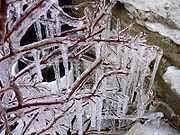
Icicle
Encyclopedia

Ice
Ice is water frozen into the solid state. Usually ice is the phase known as ice Ih, which is the most abundant of the varying solid phases on the Earth's surface. It can appear transparent or opaque bluish-white color, depending on the presence of impurities or air inclusions...
formed when water dripping or falling from an object freezes. Typically, icicles will form when ice or snow
Snow
Snow is a form of precipitation within the Earth's atmosphere in the form of crystalline water ice, consisting of a multitude of snowflakes that fall from clouds. Since snow is composed of small ice particles, it is a granular material. It has an open and therefore soft structure, unless packed by...
is melted by either sunlight or some other heat source (such as heat leaking from the interior of a heated building), and the resulting melted water runs off into an area where the ambient temperature is below the freezing point of water (0 °C/32 °F), causing the water to refreeze. Over time continued water runoff will cause the icicle to grow.
Icicles can pose both safety and structural dangers. Icicles that hang from an object may fall and cause injury and/or damage to whoever or whatever is below them. In addition, ice deposits can be heavy. If enough icicles form on an object, the weight of the ice can severely damage the structural integrity of the object and may cause the object to break.
"Brinicles
Ice stalactite
An ice stalactite forms beneath sea ice when a flow of extremely cold, saline water is introduced to an area of ocean water, being the undersea equivalent of a stalactite or icicle....
", underwater icicles that form around salty water sinking from sea ice, have been observed near Antarctica.

